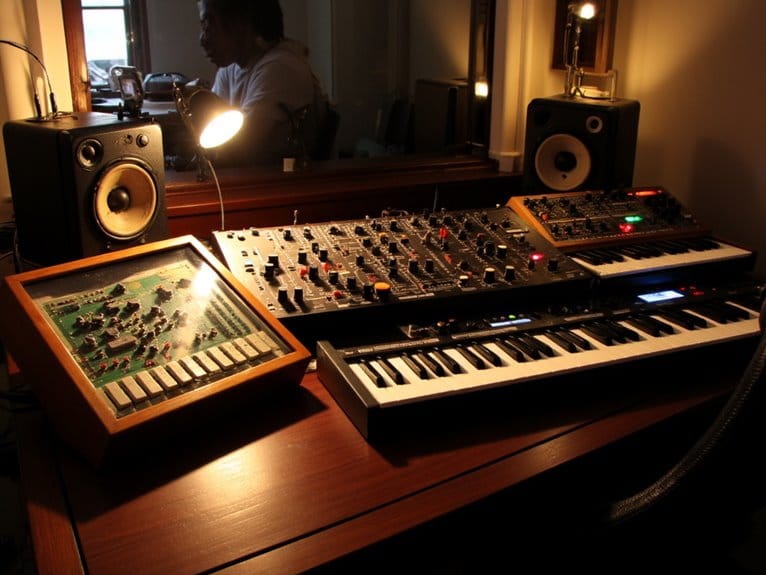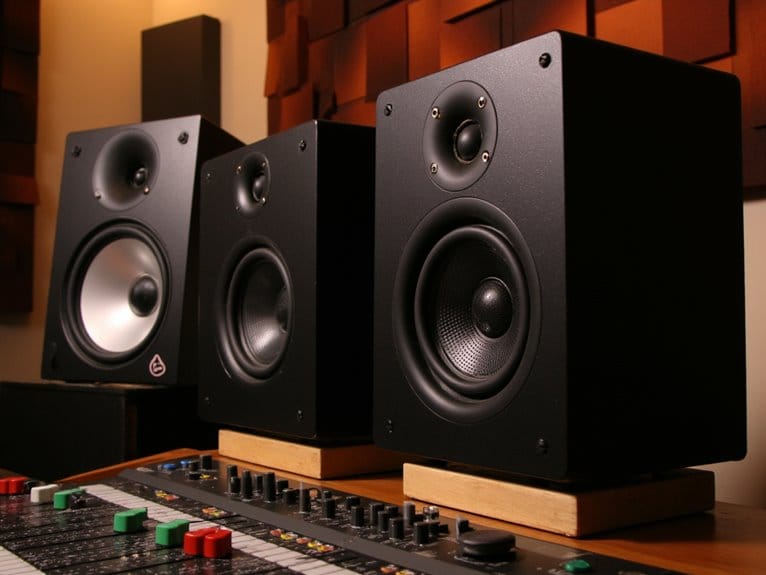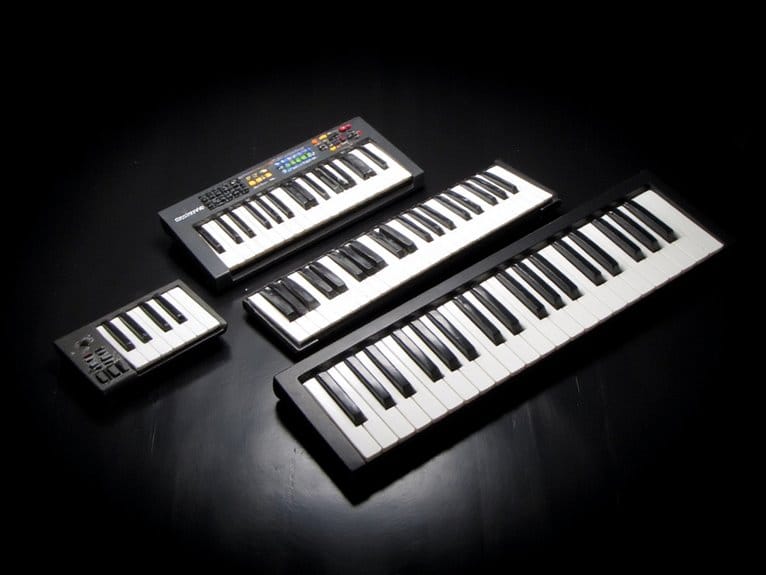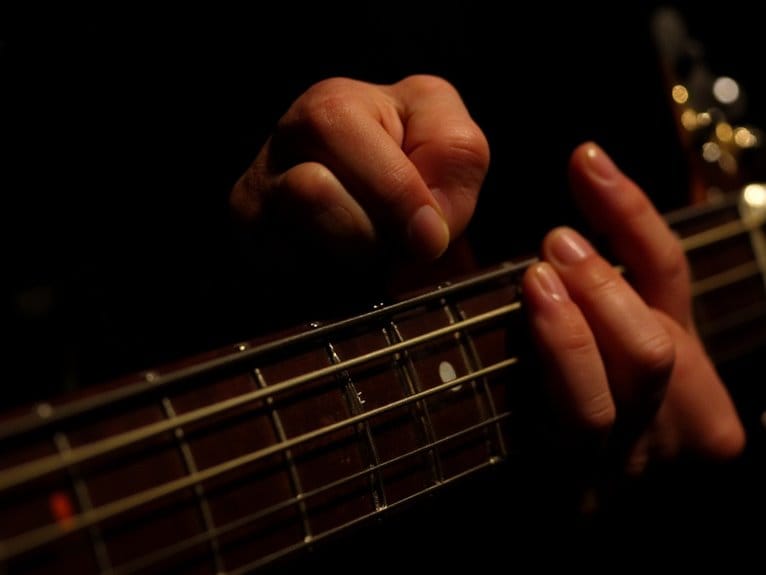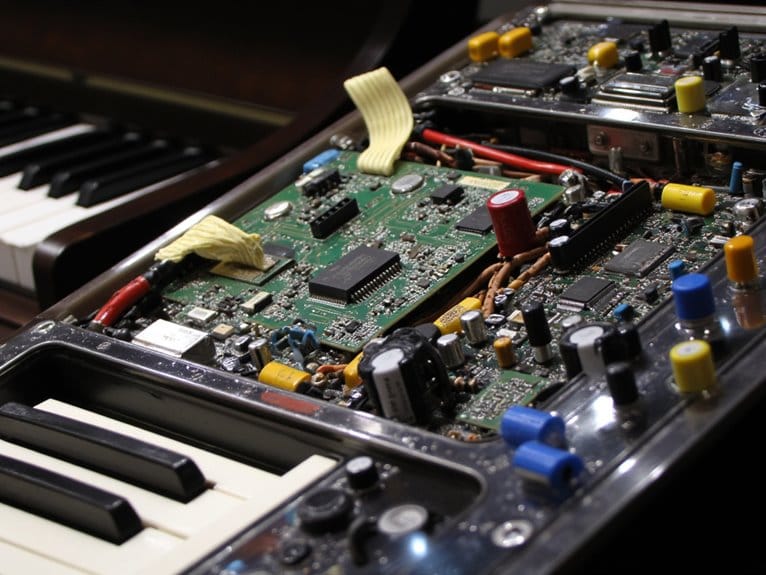Synthesizer Types: Mono, Poly, and Paraphonic Explained
You’ll encounter three main synthesizer architectures that fundamentally shape your sound possibilities. Monophonic synths produce one note at a time through a single signal path, delivering focused, punchy tones perfect for cutting leads and bass lines in electronic music. Polyphonic synthesizers provide independent signal paths for each voice, allowing simultaneous notes with complete harmonic complexity ideal for rich pads and chords. Paraphonic designs split the difference, offering multiple oscillators for different pitches while sharing filters and processing components, creating unique blended textures. Understanding these architectural differences will guide you toward the perfect instrument for your musical goals.
We are supported by our audience. When you purchase through links on our site, we may earn an affiliate commission, at no extra cost for you. Learn more.
Notable Insights
- Monophonic synthesizers play one note at a time through a single signal path, ideal for cutting leads and punchy bass lines.
- Polyphonic synthesizers allow multiple simultaneous notes with independent signal paths per voice, enabling complex chords and rich harmonic textures.
- Paraphonic synthesizers generate multiple pitches independently but share processing components like filters, creating cohesive blended sounds with uniform modulation.
- Monophonic synths excel in electronic dance music and hip hop for their focused, powerful tones and affordable entry point.
- Polyphonic synths suit jazz, ambient, and complex compositions requiring harmonic flexibility, while paraphonic synths offer unique experimental textures.
What Makes a Synthesizer Monophonic
Simplicity—that’s the defining characteristic of monophonic synthesizers, instruments that produce only one note at a time despite potentially housing multiple oscillators under the hood. When you press multiple keys simultaneously, you’ll only hear the latest note pressed, which represents one of the most significant monophonic limitations compared to their polyphonic cousins.
However, don’t let this restriction fool you into thinking these synths are weak—classic instruments like the Minimoog pack three oscillators into a single voice, creating thick, rich textures with unmistakable analog warmth. The last note priority system means that when multiple keys are pressed, the earliest played note is cut off as the new one triggers.
I’ve found that monosynths excel at cutting lead lines and punchy bass parts where focused clarity matters more than harmonic complexity, making them indispensable for genres emphasizing melodic solos over chord progressions. Modern analog bass synthesizers like the Behringer TD-3 series continue this tradition, delivering authentic analog growl that’s particularly effective for acid house and techno production.
The distinctive character of monophonic synthesizers has made them essential in modern music genres such as Electronic Music, Synthpop, Hip Hop, and Trap, where their focused single-voice output creates the signature sounds that define these styles.
Understanding Polyphonic Synthesis Architecture
When you move from monophonic to polyphonic synthesis, you’re entering a world where each note you play gets its own complete signal path, featuring dedicated oscillators, filters, and amplifiers that work independently from every other voice.
This architecture means you can press multiple keys simultaneously and hear each note with its own distinct envelope behavior, filter movement, and modulation characteristics, rather than having voices compete for shared components.
I’ve found that understanding these independent voice signal paths is essential because it’s what separates true polyphony from paraphonic designs, where you might get multiple oscillators but still share filters or amplifiers across voices, limiting your expressive control.
Modern software synthesizers leverage increased processing power to deliver hundreds or even thousands of simultaneous voices, far exceeding the capabilities of early hardware instruments.
Independent Voice Signal Paths
The architecture of independent voice signal paths represents one of the most sophisticated approaches to polyphonic synthesis, where each voice maintains its own complete signal chain of oscillators, filters, and amplifiers rather than sharing components across multiple notes.
This design offers exceptional voice signal flexibility, allowing you to shape each note independently without compromise. Unlike early polyphonic synthesizers that shared filter stages through multiplexed control, modern independent architectures provide dedicated parameter sets per voice, enabling precise parameter customization for oscillator tuning, filter cutoff, and envelope shapes.
Cherry Audio’s Eight Voice exemplifies this approach with eight fully independent dual-oscillator modules, while digital voice allocation systems handle seamless polyphonic control routing and dynamic voice stealing for smooth performance.
True Polyphony Benefits
While independent voice architectures provide the foundation for sophisticated polyphonic synthesis, it’s the resulting benefits of true polyphony that transform how we approach musical creation and performance. True polyphony enables each note to maintain its own complete synthesis path, allowing for incredibly nuanced expressive performance where every keystroke retains individual character and articulation.
| Benefit Category | Musical Impact | Technical Advantage |
|---|---|---|
| Textural Complexity | Richer layered sounds | Independent envelope shaping |
| Sound Design Flexibility | Dynamic evolving textures | Per-voice modulation control |
| Performance Expression | Nuanced dynamics per note | Individual articulation paths |
| Harmonic Clarity | Complex chords without artifacts | Separate voice processing |
You’ll find that true polyphony supports everything from realistic acoustic emulations to experimental sound design, though it demands more resources and careful programming considerations. Modern polyphonic synthesizers like the Behringer UB-Xa and Arturia MiniFreak showcase these capabilities with their multi-voice engines that enable complex arrangements and layered textures. Modern digital synthesizers leverage subtractive synthesis and other sound engine types to deliver these polyphonic capabilities across various price points and feature sets.
Imagine having the ability to play chords on your synthesizer, but with a twist that fundamentally changes how those notes behave compared to what you’d expect from a piano or fully polyphonic instrument.
Paraphonic synthesizers offer this unique experience by providing independent oscillator control for multiple notes while routing everything through shared signal processing components like filters and amplifiers.
This architecture creates layered sounds with shared articulation, where all notes respond to the same envelope generators and modulation sources simultaneously.
You’ll find these paraphonic capabilities in classic string machines like the Roland RS-202 and modern multi-oscillator monosynths configured for chord play, delivering cohesive textures that blend individual pitches into composite outputs rather than maintaining complete note independence.
Duophonic Systems: The Two-Voice Bridge
Between the monophonic world and the emerging polyphonic landscape of the early 1970s, duophonic synthesizers carved out a fascinating niche that I’ve always found represents one of the most practical compromises in synthesizer design.
These instruments, like the legendary ARP Odyssey and Moog’s 952 keyboard, offered duophonic functionality through two oscillators that could play independently when you pressed different keys. The clever keyboard circuitry generated separate control voltages for your lowest and highest notes, giving you oscillator independence for pitch while sharing a single filter, amplifier, and envelope system.
Though this shared signal path meant both voices articulated together—sometimes creating awkward re-triggering behaviors—duophonic synths provided an affordable bridge between monophonic limitations and polyphonic complexity.
Technical Architecture Differences Between Voice Types
Understanding the technical architecture behind different synthesizer voice types reveals why a monophonic Minimoog sounds so fundamentally different from a polyphonic Prophet-5, even when they’re both playing the same musical passage.
The signal path configuration fundamentally determines each instrument’s articulative control capabilities and overall synthesizer complexity.
Here’s how oscillator types and filter design create these architectural distinctions:
- Monophonic synths route all oscillators through a single signal path, enabling precise envelope modulation but limiting polyphonic expression.
- Polyphonic synths feature independent voice allocation circuits, providing separate filters and amplifiers per note for maximum articulative control.
- Paraphonic synths split oscillator generation while sharing downstream processing, creating a hybrid approach to sound synthesis.
These architectural differences directly impact your playing experience, from how envelopes trigger to overall musical expressiveness.
Sound Character and Musical Applications
Beyond their technical differences, each synthesizer type produces distinctly different sonic characteristics that make them naturally suited for specific musical roles. I’ve found that understanding these sound qualities helps you choose the right synth for your creative goals.
You’ll discover that monophonic synthesizers excel at delivering focused, punchy tones for basslines and lead melodies, while polyphonic models offer the harmonic complexity needed for lush pads and chord progressions. Paraphonic synths provide a unique middle ground with their shared filter characteristics.
The genre you’re working in often dictates which type works best, since electronic dance music typically demands the raw power of mono synths, whereas jazz and ambient styles benefit from the rich textures that only polyphonic instruments can provide.
Sonic Characteristics by Type
When you’re choosing between different synthesizer types, the sonic differences become immediately apparent once you start playing, and I’ve found that understanding these characteristics can dramatically shape your musical decisions.
Each architecture produces distinct timbral qualities that’ll influence your creative approach, especially when you’re working with synthesizer layering techniques or complex sound modulation schemes.
Here’s how each type delivers its unique sonic signature:
- Monophonic synths excel at focused, cutting leads with exceptional clarity, making them perfect for bass lines that need to punch through dense mixes.
- Polyphonic synths create rich harmonic textures with independent voice control, enabling complex chord progressions and evolving pads.
- Paraphonic synths offer a middle ground with simultaneous notes but shared processing, resulting in smooth chord blends with slightly merged characteristics.
Genre-Specific Synth Applications
Different musical genres demand specific synthesizer characteristics, and I’ve discovered that matching the right synth type to your chosen style can make or break your productions.
Jazz pioneers like Weather Report and Miles Davis embraced synthesized textures in the 1970s, using both monophonic leads and polyphonic chords for harmonic experimentation. Modern jazz artists continue this tradition, blending electronic elements with traditional instruments.
Pop music relies heavily on catchy synth hooks, from The Monkees’ early Moog experiments to contemporary artists using bold sawtooth leads.
EDM’s genre evolution stems from Roland’s TB-303 and TR-808/909, creating foundational acid basslines and hypnotic sequences. Folk musicians incorporate subtle pads alongside acoustic instruments, while sample-based workstations provide versatile sound libraries perfect for live performances across multiple genres.
On a final note
You’ll find that choosing between mono, poly, and paraphonic synths depends entirely on your musical goals and playing style. If you’re crafting bass lines or lead melodies, monophonic’s focused character delivers unmatched punch. For complex chords and layered arrangements, polyphonic systems provide the flexibility you need. Paraphonic models offer a compelling middle ground, delivering multiple notes with shared filtering that creates unique tonal interactions you won’t get elsewhere.

